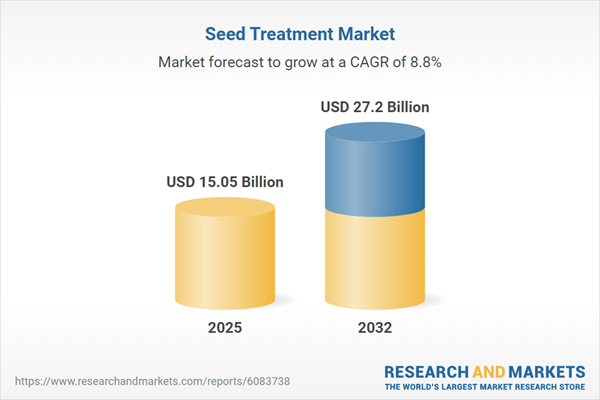Speak directly to the analyst to clarify any post sales queries you may have.
The seed treatment market is rapidly evolving, as advanced technologies, regulatory shifts, and changing grower expectations drive new solutions and commercial opportunities. Senior decision-makers must navigate increasing complexity while leveraging innovation to secure growth and resilience in this dynamic environment.
Market Snapshot: Seed Treatment Market Size and Growth
The seed treatment market grew from USD 13.89 billion in 2024 to USD 15.05 billion in 2025. Projected to expand at a CAGR of 8.76%, it is set to reach USD 27.20 billion by 2032. This continued growth is fueled by the intersection of innovation across biological and chemical technologies, adaption to regulatory developments, and transformation within both application and distribution models. Market participants are focusing on modernization and strategic investment as the industry becomes more competitive and interconnected across global and local supply chains.
Scope & Segmentation Overview
This report presents comprehensive and actionable insights, supporting strategic planning and investment for stakeholders in the seed treatment market. Analysis covers major product, crop, formulation, and commercial segments—helping leaders benchmark positioning and identify high-potential opportunities. Regional perspectives facilitate decision-making in diverse demand and regulatory environments, while segmentation enables tailored strategies for key market participants.
- Product Types: Biologicals Treatment—biofungicide, bioinsecticide, bionematicide; Chemical Seed Treatments—fungicides, insecticides, nematicides; distinctions by mode of action and microorganism base
- Crop Types: Cereals & Grains such as corn, rice, and wheat; Fruits & Vegetables; Oilseeds & Pulses including canola and soybean; Turf & Ornamentals
- Formulation Types: Emulsifiable concentrate, microencapsulated, suspension concentrate, suspoemulsion, water-dispersible granule, wettable powder
- Treatment Packages: Co-pack, custom blend, multi-active pre-mix, single-active
- Certification: Conventional options and organic-compliant categories
- Application Settings: Commercial seed plants, contract treaters, and on-farm usage
- End Users: Agricultural cooperatives, agrochemical companies, farmers and growers, government and public sector organizations, research institutes, as well as seed companies
- Distribution Channels: Offline channels such as distributors and retailers, as well as online platforms
- Regional Coverage: Americas, Europe-Middle East-Africa, and Asia-Pacific, each addressed with detailed sub-regional insights
Key Takeaways: Strategic Insights for Senior Decision-Makers
- Biological seed treatments are advancing toward widespread adoption, supporting integrated pest management solutions and reducing over-reliance on single-mode chemical approaches.
- Precision agriculture and digital traceability enable more effective quality control and product differentiation within commercial supply chains, helping stakeholders build customer trust and market segmentation.
- An increased emphasis on supply chain resilience is prompting diversification of sourcing strategies and investment in regional manufacturing or distribution capabilities to reduce logistical and regulatory risks.
- The growing demand for organic-compliant and multi-active seed treatment formulations propels innovation in formulation science and certification processes, keeping pace with evolving regulatory requirements and customer expectations.
- Collaboration is emerging as a central strategy, with leaders blending internal research, partnerships, and co-development models to expand product offerings and market presence across diverse regions and customer groups.
- Operating successfully across global markets requires regionally tailored go-to-market strategies. Product offerings and compliance approaches need to reflect mechanization needs in the Americas, regulatory demands in EMEA, and smallholder priorities in Asia-Pacific.
Tariff Impact: United States 2025 Measures
Recent tariff changes in the United States are reshaping procurement and cost management for seed treatment products and ingredients. Organizations are shifting to nearshoring and diversifying suppliers to control costs and maintain agility. In response, growers and seed companies are also re-evaluating product selections and partnership models to manage price and supply variability. These adjustments support a more flexible, resilient approach to ongoing trade and pricing pressures.
Methodology & Data Sources
Research combined targeted interviews with market participants and thorough analysis of regulatory filings, patents, and industry publications. Data triangulation ensures the credibility of findings, while scenario-based and qualitative analysis adds depth to risk assessment and commercial context.
Why This Report Matters
- Empower strategic planning with validated intelligence on trends, innovation, and regulatory change in the seed treatment landscape.
- Achieve competitive advantage by benchmarking your portfolio and investments within segmented market and regional contexts.
- Navigate complexity in supply chain management, certification, and partnerships through practical, evidence-based insights that support sound decision-making.
Conclusion
The seed treatment market is progressing through technical advances, regulatory adjustments, and evolving value chain needs. Executives can secure sustainable growth and market relevance by leveraging research-backed insights and targeted commercial strategies.
Table of Contents
3. Executive Summary
4. Market Overview
7. Cumulative Impact of Artificial Intelligence 2025
Companies Mentioned
The companies profiled in this Seed Treatment market report include:- BASF SE
- Syngenta AG
- Certis Belchim Group
- Albaugh LLC
- Bayer AG
- Corteva Agriscience by DuPont de Nemours, Inc.
- Croda International PLC
- Eastman Chemical Company
- FMC Corporation
- Novozymes A/S
- Nufarm Ltd.
- Solvay S.A
- Sumitomo Chemical Co. Ltd.
- UPL Ltd.
- Verdesian Life Sciences, LLC
- Germains Seed Technology
- Precision Laboratories, LLC
- Koppert Biological Systems BV
- Rizobacter by Bioceres Crop Solutions Corp.
- Germains Seed Technology
- Andermatt Group AG
- PI Industries Ltd.
- Plantae Labs
- ICL Group
- Dioxd
- Heliae Development, LLC
- South Pacific Seeds
- Yara International ASA
- Organica Biotech Pvt. Ltd.
- MaxEEma Biotech Private Limited
- Kimitec Group
- AgriLife (India) Pvt Ltd.
- BioWorks, Inc. by Biobest Group NV
- Little's Agrivet
- Grow Indigo Private Ltd
- SEEDPOLY Biocoatings Private Limited
Table Information
| Report Attribute | Details |
|---|---|
| No. of Pages | 191 |
| Published | November 2025 |
| Forecast Period | 2025 - 2032 |
| Estimated Market Value ( USD | $ 15.05 Billion |
| Forecasted Market Value ( USD | $ 27.2 Billion |
| Compound Annual Growth Rate | 8.7% |
| Regions Covered | Global |
| No. of Companies Mentioned | 37 |









